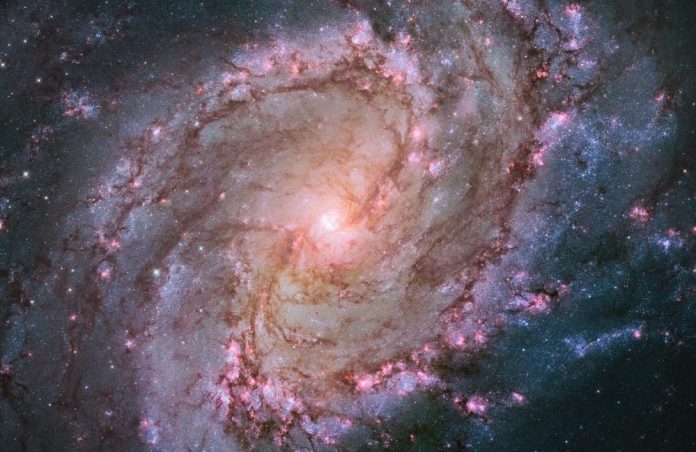
Galaxies have an overall internal motion called disk velocity. It’s how gas, dust, and stars move around the galactic center.
It’s not a single value but a velocity profile that varies depending on distance from the center.
When astronomers spot something in a galaxy that’s not moving according to the disk velocity, it catches their attention. That’s what happened with M83.
M83, or the Southern Pinwheel galaxy, is one of the closest and brightest barred spiral galaxies. It’s about 15 million light-years away and is visible in binoculars.
Astronomers have been puzzled by active star formation in the galaxy, where they thought that there wasn’t enough material to form new stars.
A team of Japanese researchers may have the answer.
Their research, “High-velocity Molecular Clouds in M83,” is published in The Astrophysical Journal. The lead author is Maki Nagata, a graduate student and astronomer at the University of Tokyo’s Institute of Astronomy. The research is aimed at answering a lingering question about galaxies that has so far not been answered: How do galaxies get fresh gas to keep star-formation going long after it should’ve ceased?
“Our results show that galaxies are not isolated but constantly interact with their surroundings.” – Maki Nagata, University of Tokyo.
The researchers used radio astronomy data from the Atacama Large Millimeter/submillimeter Array (ALMA), Earth’s most complex and powerful radio telescope array, to find an answer. M83 is face-on from our viewpoint, and ALMA was able to acquire high spatial-resolution, high sensitivity data on the motion of carbon monoxide (CO) in the galaxy. Astronomers use CO as a tracer for molecular hydrogen, the gas that forms stars.
The Japanese team found multiple clouds of star-forming gas in M83 with unusual velocities relative to the galactic disk. These high-velocity clouds (HVC) could be how galaxies acquire fresh gas to sustain star formation long after it should’ve ceased.
“We identified molecular clouds and searched for clouds with velocities deviating by more than 50 km s−1 from the disk velocity field as HVCs,” the authors explain in their research. “A total of 10 HVCs were detected—9 redshifted and 1 blueshifted—clearly highlighting an asymmetry in their velocity distribution.” These 10 clouds were 1% of all clouds the team found.
The HVCs have radii spanning 30 to 80 parsecs and masses around 105 solar masses. Their velocity dispersions range from 3–20 km s−1, meaning their range is higher than regular disk clouds.
Our own Milky Way galaxy has HVCs that exceed the disk rotation velocity. “Their origins are thought to be associated with Galactic fountain, gas accretion from satellite galaxies, or the cooling of overdense regions in the multiphase halo medium,” the authors explain in their research. Unfortunately, astronomers ability to study them is limited because we’re inside the galaxy. But M83’s face-on orientation makes it an ideal galaxy to study gas clouds and HVCs.
“Gas clouds are a common feature of galaxies. Some are classed as high-velocity clouds (HVCs) and we suspected these might account for some of this galactic feeding material,” lead author Nagata said in a press release. “What makes HVCs special is that their speed and direction don’t correspond to the general speed of rotation or the orientation of a typical spiral galaxy. This alone doesn’t necessarily mean they come from outside the host galaxy, though one scenario is that they start as material ejected by supernova, exploding stars. But we thought with the right analysis and reasoning, we could tell if at least some HVCs were from outside the galaxy.”
Active Galactic Nuclei (AGN) can create HVCs with their powerful outflows, jet interactions, and feedback mechanisms. But M83 doesn’t have an AGN, so that source is ruled out, too. “Because M83 does not show any evidence of AGN activity, we considered two possible origins for these HVCs: supernovae or inflowing gas from outside the galactic disk,” the researchers write in their article.
Only one of the ten HVCs the team identified could be traced to a supernova explosion. The remaining nine couldn’t be explained by supernovae or other local phenomenon. Their kinetic energies also didn’t agree with supernova ejecta, further evidence that they originated outside of M83 and found their way in somehow.
The discovery adds to the idea that everything is interconnected and that galaxies aren’t necessarily discrete objects. They’re affected by external processes that help shape their evolution.
“Our results show that galaxies are not isolated but constantly interact with their surroundings. The discovery of HVCs falling into M83 suggests that galaxies can grow by accreting gas from the space around them, possibly from smaller neighboring galaxies or the intergalactic medium,” said Nagata in the press release announcing the research.
“While HVCs are typically low-density atomic hydrogen gas, something that surprised us in this study was that the clouds were found to be compact and made of dense molecular gas, exactly the type of gas that forms new stars. This suggests that the inflowing material may be directly connected to future star formation.”
M83 and the Milky Way are quite similar, so what astronomers learn about M83 could apply to our galaxy, too.
“Our next steps include investigating how these molecular HVCs formed and whether they were once atomic gas,” said Nagata.
“By examining their relationship to other gas structures such as neutral atomic hydrogen.
We will also explore whether these inflowing clouds could trigger new star formation when they collide with the galaxy’s disk. This would finally help answer the outstanding question we asked ourselves before.”
Written by Evan Gough/Universe Today.



